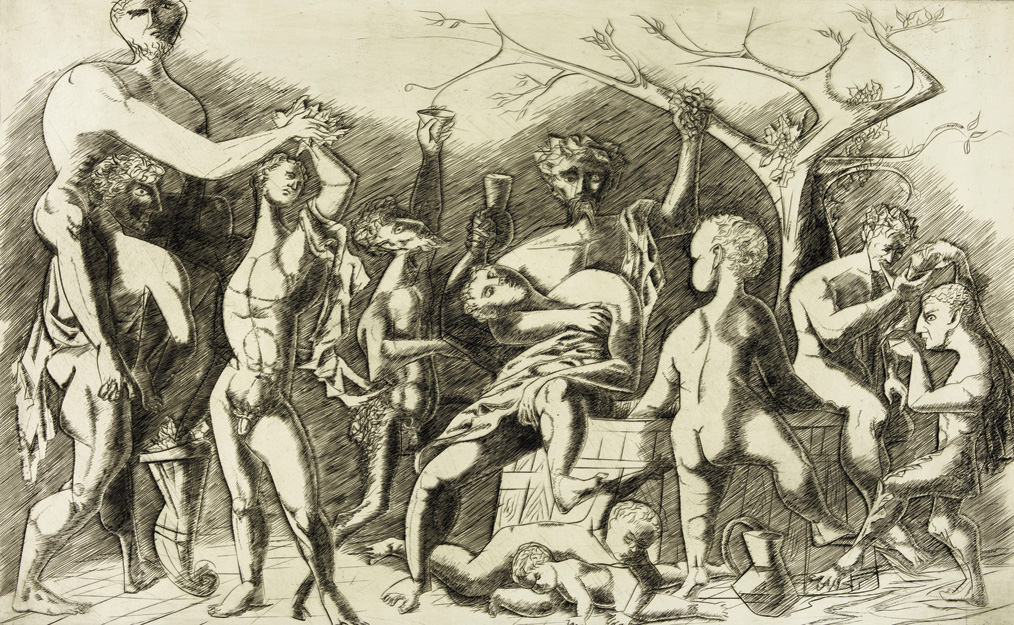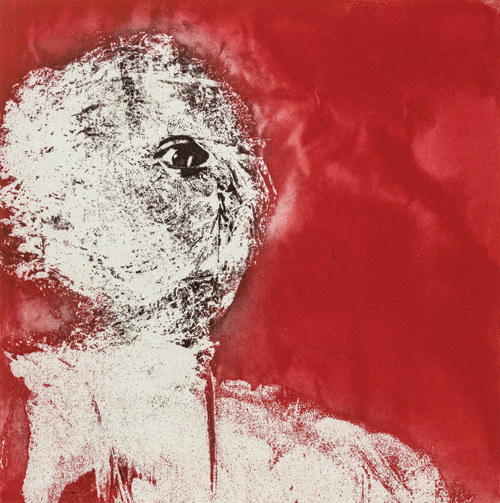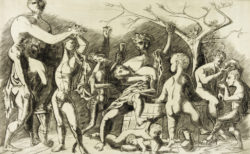Summer 2017
Restlessly Inventive
Jim Steg was the most influential printmaker to be based in New Orleans in the twentieth century.
Published: June 1, 2017
Last Updated: October 4, 2021

Courtesy of the New Orleans Museum of Art
Bacchanalian, Jim Steg.
Jim Steg: New Work, a comprehensive exhibition of the late artist’s work, remains on view at the New Orleans Museum of Art (NOMA) through October 8, 2017. This exhibition reveals Steg as both an innovator in the field of printmaking and an artist at the forefront of several major twentieth-century movements. Etchings, woodcuts, drawings made during World War II, photo-resist etchings, Xerox toner works, and many other works that have never before been on public display are included in the artist’s first retrospective exhibition since a monographic show in 1978, which NOMA also presented.
James Louis Steg was born in Alexandria, Virginia, in 1922 and was raised on a farm in Churchville, New York, southwest of Rochester. As a high school student, he showed an interest in cartooning and even developed a loopy autograph that he thought befitting of the trade, a signature that occasionally appears on his earliest serious works, too.

Jim Steg, One-Eyed. Courtesy of the New Orleans Museum of Art
Following studies at the Art Institute of Chicago, Steg enlisted in the United States Army. He served as part of a World War II division now known as the Ghost Army, which was responsible for deceiving the armies of the Third Reich by faking troop movements using inflatable tanks and other theatrical props and equipment. The largest body of work that Steg produced during the war consists of dozens of graphite or watercolor portraits of civilians, soldiers, or refugees that he encountered during his service, portraits that he called “spontaneous impressions.”
Beginning in the late 1940s, Steg showed an interest in the history of printmaking. Sometimes this interest resulted in reinterpretations of classic prints, as in his Bacchanalian Group after Mantegna, in which he takes the sculpted, knobby, frieze-like figures in the Andrea Mantegna print from the late fifteenth century and reimagines them as a collection of sharper, hard-edged, modernist figures reminiscent of Pablo Picasso’s more classically inspired works. Later in his career, Steg would use the photo-resist etching process to quote directly from earlier prints: Why?, from 1972, includes a reproduction of Albrecht Dürer’s Melencolia I, in the small predella-style panel at the top of the print, echoing the introspective nature of the title, and ominously surmounting the seemingly interred visage below it
Restlessly inventive, Steg also worked with Polaroid prints and sculpted wood with chainsaws toward the end of his career, and he created intricate dioramas that often included collaged elements from his own earlier printed work. He also continued to instruct students at Tulane University until his retirement in 1990. When he died in 2001, Steg left behind an incredible legacy of countless students and a remarkable achievement in a wide variety of media. Today, his prints are in the collections of the Metropolitan Museum of Art, The Museum of Modern Art in New York, The National Gallery, and many others. In 1975 the New Orleans Museum of Art acquired more than fifty of his works, many of which were presented three years later in Steg’s last major exhibition. This year’s exhibition expands upon the earlier one and aims to return Steg to his rightful position as one of the nation’s most innovative and exciting printmakers.
___
Russell Lord, Freeman Family Curator of Photographs, Prints and Drawings

